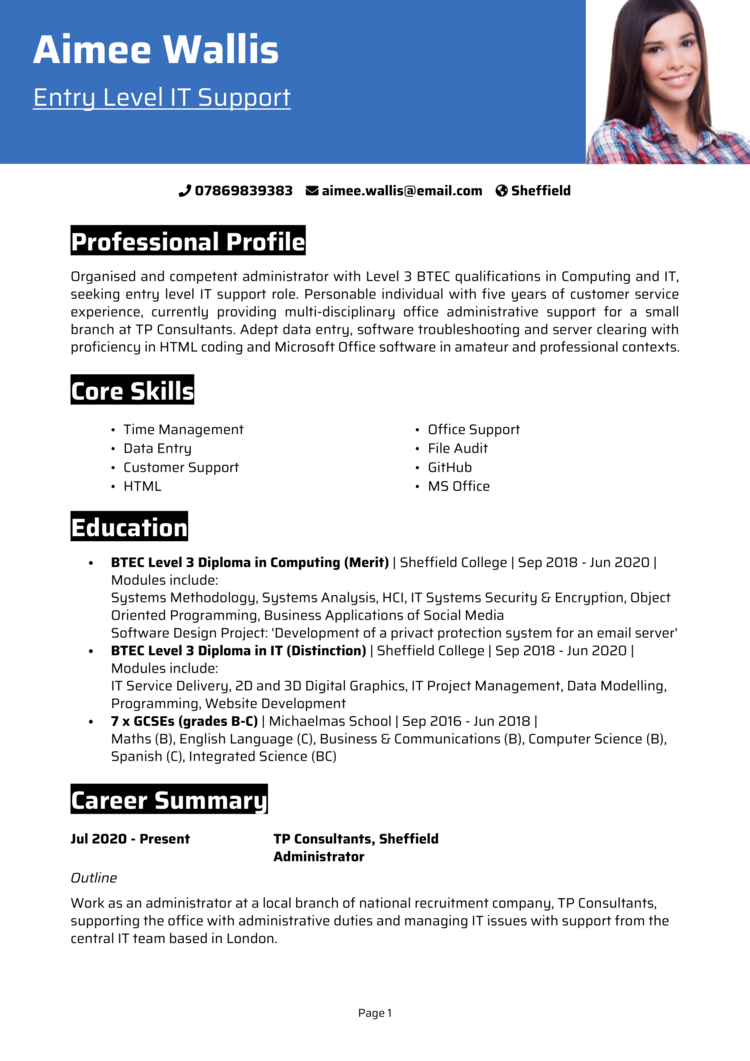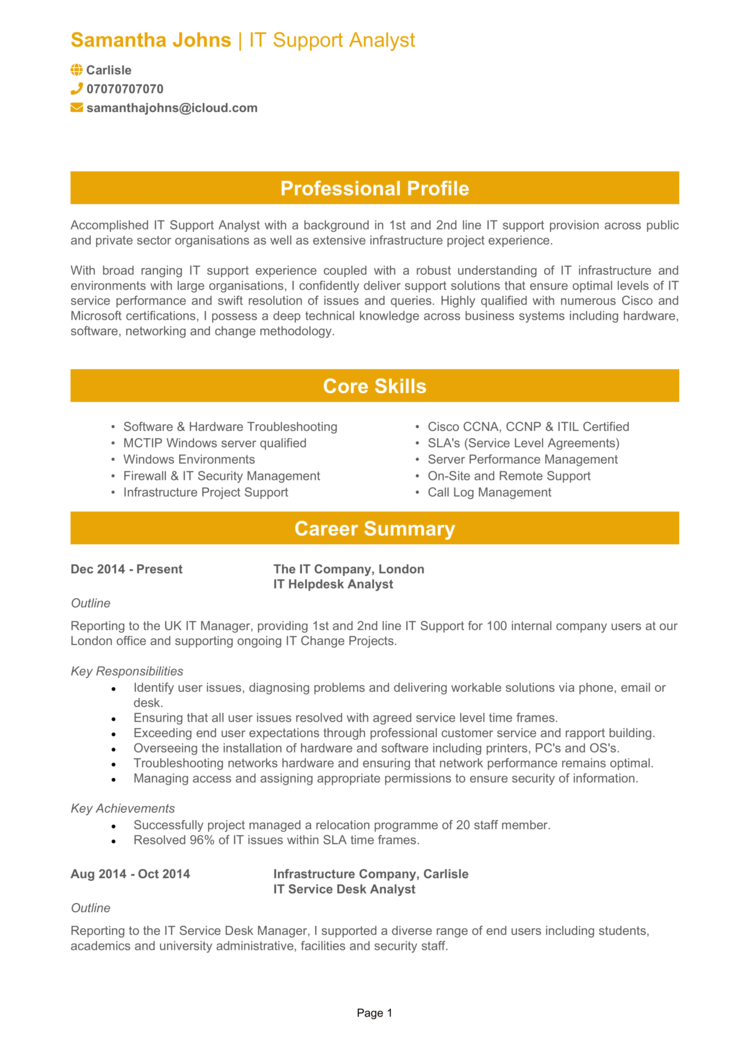Do you love fixing things faster than someone can say “Have you tried turning it off and on again?”
As an IT Technician, you’re the unsung hero of the digital world, keeping systems running and users happy. But before you can troubleshoot someone else’s problems, there’s one system you need to perfect: your CV.
This guide, complete with 3 helpful IT Technician CV examples, will help you craft an application that stands out and secures your next role.
IT Technician CV

Entry Level IT Support CV

IT Support Analyst CV

How to write your IT Technician CV
Learn how to create your own interview-winning IT Technician CV with this simple step-by-step guide.
This guide will walk you through writing an IT Technician CV that showcases your technical expertise, problem-solving abilities, and knack for keeping technology in check. By the end, you’ll have a CV that upgrades your career to the latest version.
IT Technician CV structure


Think of your CV as your own diagnostics report – it needs to be clear, concise, and packed with the skills that make you the perfect fit. But this is only achievable with a well-structured application which recruiters can comprehend at a glance.
Here’s how to structure your IT Technician CV:
- Name and contact details – Keep your contact details at the top for quick reference. Optionally, include a photo – it’s entirely up to you.
- CV profile – Start things off with a summary of your technical expertise and problem-solving abilities.
- Core skills – List the most relevant hard skills, such as hardware troubleshooting, network management, and software installation.
- Work experience – Here, you’ll need to walk through your roles in reverse chronological order, focusing on key achievements.
- Education – Outline your education and certifications, focusing additional detail on those most relevant to the role.
- Additional info – You can add hobbies and interests or activities here that reflect your enthusiasm for technical pursuits.
IT Technician CV format


Your CV format should reflect your technical precision and attention to detail. Poor formatting can make even the most qualified candidate look unorganised, so ensure it’s clear and professional.
A well-formatted CV makes it easy for recruiters to focus on your skills and experience instead of struggling to navigate cluttered content.
Here’s a few good tips to format your IT Technician CV:
- Bullet points – Use short, sharp bullet points to present your responsibilities and achievements clearly.
- Divide sections – Employ bold headings and consistent spacing to make your CV easy on the eye and even easier to navigate
- Use a clean font – Opt for a clean, clear font to make your CV polished and easy to read. Also, stick to a consistent design and layout.
- No more than 2 pages – Keep it concise while covering all essential details: don’t bury your skills underneath unnecessary fluff.
IT Technician CV profile


Your CV profile is the first thing recruiters will read, so make it count. For an IT Technician, it’s an opportunity to highlight the top qualifications that make you the perfect fit, and demonstrate the value you’ll bring to the recruiter’s firm.
IT Technician CV profile examples
Profile 1
Organised IT Technician with four years of experience in providing technical support within the education sector. Skilled in diagnosing hardware and software issues, maintaining network infrastructure, and ensuring system security. Proficient in using Active Directory and remote desktop tools for efficient troubleshooting.
Profile 2
Reliable IT Technician with three years in the healthcare industry, focusing on maintaining IT systems for critical operations. Experienced in setting up hardware, supporting software deployments, and training staff on new technologies. Proficient in using ServiceNow for ticket management and SolarWinds for network monitoring.
Profile 3
Dedicated IT Technician with over six years of experience in corporate IT environments, specialising in system installations, upgrades, and user support. Skilled in Windows Server management, Office 365 administration, and ensuring compliance with ITIL standards.
What to include in your IT Technician CV profile
Tailor your profile to the role by referencing the key technologies, certifications, and achievements the employer values most.
Here’s what to include in your IT Technician CV profile:
- Where you’ve worked – Mention industries or organisations you’ve provided IT support for, and the level of experience you’ve got.
- Your top qualifications – Highlight certifications like CompTIA A+, Microsoft Certified: Azure Fundamentals, or similar.
- Essential skills – Include abilities like hardware troubleshooting, network configuration, or software installation – these will probably change depending on the job you’re applying for.
- People you’ve supported – Reference your experience assisting users, from frontline employees to senior executives.
- Systems you’ve maintained – Mention specific systems or technologies you’ve managed, like Windows Server, Linux environments, or cloud-based platforms.
How should you write a core skills section?


Your core skills section is like your IT toolkit – it shows recruiters the key abilities you’ll bring to the role.
Adjust this section to the job description by focusing on the skills that align most with the employer’s needs.
Best skills for your IT Technician CV
- Hardware Troubleshooting – Diagnosing and resolving issues with desktops, laptops, and peripherals.
- Network Configuration – Setting up and maintaining wired and wireless networks for seamless connectivity.
- Software Installation and Support – Installing and configuring software to meet organisational needs.
- System Maintenance – Performing updates, backups, and security patches to ensure system reliability.
- Customer Support – Providing technical assistance and training to non-technical users.
- Operating Systems Expertise – Managing Windows, macOS, and Linux environments effectively.
- Remote IT Support – Using remote tools to resolve issues for geographically dispersed teams.
- Incident Management – Logging, prioritising, and resolving tickets using tools like ServiceNow or Jira.
- Cybersecurity Awareness – Implementing basic security protocols to safeguard systems and data.
- Printer and Peripheral Management – Installing and maintaining printers, scanners, and other devices.
What’s the correct way to structure your job history on your CV?


Recruiters want to see how you’ve applied your impressive skills to real-world environments, and the tangible impact you’ve had on companies and their clients. The work experience section will take up the bulk of your application.
List your roles in reverse chronological order, focusing on your responsibilities and achievements in each position. If you’re newer to the field, include internships, volunteer work, or personal projects that showcase your abilities and ambition.
How to present past roles for an IT Technician

- Outline – Briefly describe the organisation, your role, and the type of IT support you provided.
- Responsibilities – Highlight key tasks like troubleshooting, managing systems, or supporting users. Use action verbs like “resolved,” “configured,” or “optimised.”
- Achievements – Quantify your successes, such as reducing ticket resolution times or improving system uptime. Numbers always leave a strong impression!
Example jobs for IT Technician
IT Technician | St George’s Academy
Outline
Provided IT support for a secondary school, ensuring all hardware, software, and network systems operated efficiently. Focused on resolving technical issues and maintaining smooth daily operations.
Responsibilities
- Diagnosed and resolved hardware and software issues for staff and students.
- Installed and maintained PCs, printers, and other peripherals across the campus.
- Managed user accounts and permissions using Active Directory.
- Configured and supported classroom technology, including interactive whiteboards.
- Monitored network performance and performed routine maintenance to prevent downtime.
Achievements
- Reduced ticket resolution time by 30% by streamlining support processes.
- Successfully deployed a school-wide upgrade to Windows 11 within one holiday period.
- Received positive feedback from staff for delivering efficient and friendly technical support.
Support IT Technician | Northwest Health
Outline
Supported IT operations for a busy healthcare facility, ensuring reliable access to critical systems and maintaining data security. Focused on minimising downtime and improving staff productivity.
Responsibilities
- Set up and configured new workstations and mobile devices for staff.
- Responded to technical support requests via ServiceNow, resolving issues efficiently.
- Maintained and monitored network infrastructure, including switches and routers.
- Implemented security updates and patches to safeguard sensitive patient data.
- Trained staff on the use of new software and systems to enhance productivity.
Achievements
- Achieved a 95% first-call resolution rate for support tickets.
- Reduced downtime by 20% through proactive monitoring and maintenance.
- Streamlined onboarding processes for new employees, cutting setup time by 25%.
IT Manager | Peterson Insurance
Outline
Managed IT support services for a mid-sized corporate office, ensuring all systems and devices functioned reliably. Focused on hardware maintenance, software deployment, and user assistance.
Responsibilities
- Installed and configured hardware, software, and network systems for new employees.
- Performed regular backups and monitored storage systems to ensure data integrity.
- Troubleshot and resolved connectivity issues for office and remote workers.
- Maintained an inventory of IT equipment and ensured timely replacements.
- Provided end-user training on Microsoft Office 365 and other productivity tools.
Achievements
- Reduced helpdesk response times by 15% through improved ticket prioritisation.
- Implemented a new asset management system, increasing equipment tracking accuracy.
- Recognised by management for consistently exceeding support service benchmarks.
Structuring your education section


The education section highlights the qualifications and training that underpin your expertise as an IT Technician. Include degrees, certifications, and relevant professional development.
If you’re newer to the field, emphasise coursework, IT-related projects, or technical training that showcases your potential. For experienced candidates, focus on key qualifications and certifications.
List your qualifications in reverse chronological order, starting with the most recent.
Best qualifications for IT Technicians
- CompTIA A+ Certification – Covers essential IT skills, including troubleshooting and hardware support.
- Microsoft Certified: Azure Fundamentals – Demonstrates proficiency in cloud services and Microsoft’s Azure platform.
- Cisco Certified Technician (CCT) – Validates skills in network diagnostics and system maintenance.
- ITIL Foundation Certification – Focuses on IT service management principles and practices.
- Bachelor’s Degree in Information Technology or Computer Science – Provides a strong academic foundation for IT roles.





